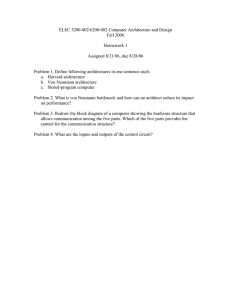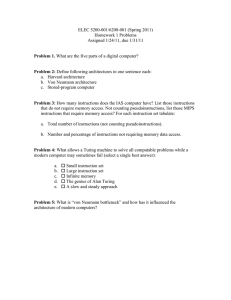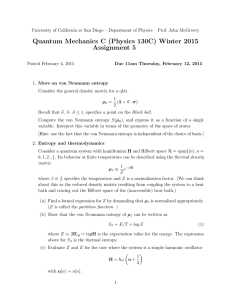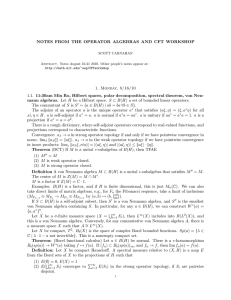Physics A Variational Expression for the Relative Entropy
advertisement
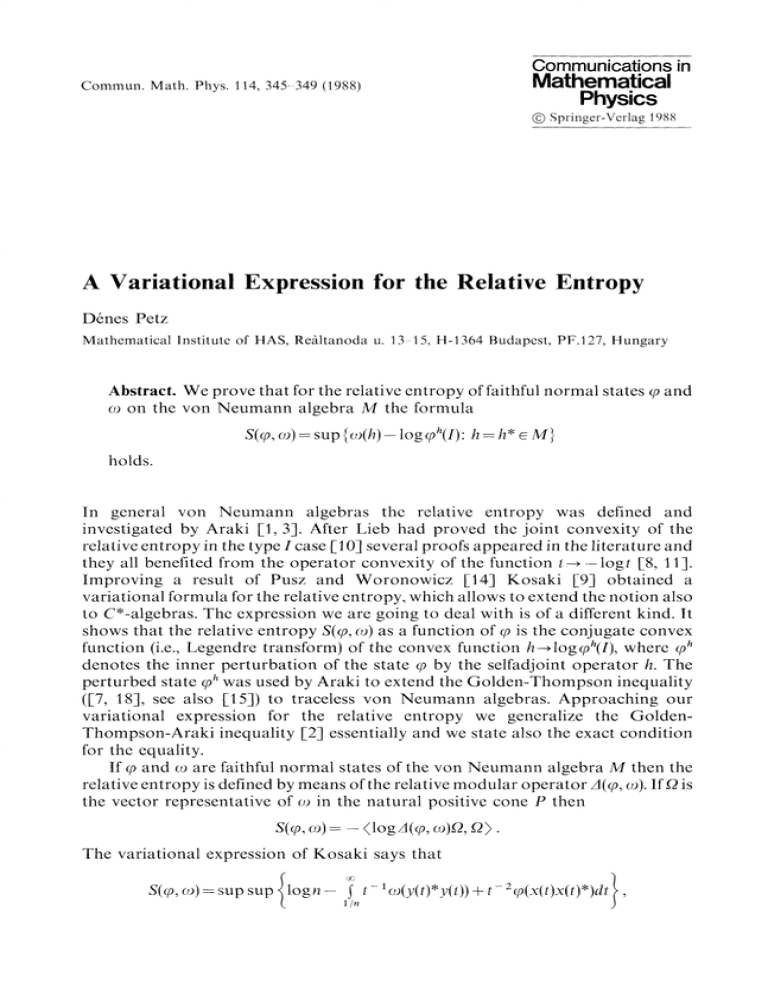
Communications in
Commun. Math. Phys. 114, 345-349 (1988)
Mathematical
Physics
© Springer-Verlag 1988
A Variational Expression for the Relative Entropy
Denes Petz
Mathematical Institute of HAS, Realtanoda u. 1 3 1 5 , H-1364 Budapest, PF.127, Hungary
Abstract. We prove that for the relative entropy of faithful normal states φ and
ω on the von Neumann algebra M the formula
S(φ,ω) = sup{ω(Λ)-logφ h (/): h = h*eM]
holds.
In general von Neumann algebras the relative entropy was defined and
investigated by Araki [1, 3]. After Lieb had proved the joint convexity of the
relative entropy in the type / case [10] several proofs appeared in the literature and
they all benefited from the operator convexity of the function t~>— logί [8, 11].
Improving a result of Pusz and Woronowicz [14] Kosaki [9] obtained a
variational formula for the relative entropy, which allows to extend the notion also
to C*-algebras. The expression we are going to deal with is of a different kind. It
shows that the relative entropy S(φ, ω) as a function of φ is the conjugate convex
function (i.e., Legendre transform) of the convex function /z->logφ A (/), where φh
denotes the inner perturbation of the state φ by the selfadjoint operator h. The
perturbed state φh was used by Araki to extend the Golden-Thompson inequality
([7, 18], see also [15]) to traceless von Neumann algebras. Approaching our
variational expression for the relative entropy we generalize the GoldenThompson-Araki inequality [2] essentially and we state also the exact condition
for the equality.
If φ and ω are faithful normal states of the von Neumann algebra M then the
relative entropy is defined by means of the relative modular operator Δ(φ, ω). If Ω is
the vector representative of ω in the natural positive cone P then
S(φ, ω)- - <logΛ(φ, ω)Ω, β> .
The variational expression of Kosaki says that
D. Petz
346
where y(t) = I — x(t), the first sup is taken over the positive integers and the second
one is over all step functions x : [1/w, oo)->M such that the range of x is finite and
x(t) = 1 for t large enough.
For a cyclic and separating vector ΦeP and a selfadjoint element heM the
perturbed vector Φh is defined by
φΛ
=
oo
1/2
w=0
0
where A is the modular operator of φ. The perturbed functional is the
nonnormalized vector functional corresponding to Φh. The inequality
reduces to the Golden-Thompson inequality if the algebra admits a faithful normal
trace.
If φ and ω are faithful normal states on the von Neumann algebra M then ω is
of the form φh for some h = h*eM provided that there are some constants λ, μ > 0
such that φ^λω^μφ [1]. This Λ is called the relative Hamiltonian.
Proposition 1. Let φ and ω be faithful normal states on the von Neumann algebra M
and h = h*eM. Then
and the equality holds if and only if ω = φh/φ\I).
Proof. By Theorem 3.10 of [3] we have S(φh, ω) = S(φ, ω) — ω(h). The monotonicity
of the relative entropy gives that S(φh, ω) ϊ> ω(I) [log ω(I) — log ψ\I}~] . Theorem 4 of
[12] tells us that here the equality holds if and only if
[Dφ\ Dω]t = (φ*(/)/ω(/)f
(* e R) ,
that is, φh = λω with a / e R + such that φh(I) = λω(I).
Corollary 2. logφ h (/) = sup{ω(/z) — S(φ,ω): ω is a faithful normal state}.
Corollary 3 (cf. [2]). The function h-^\ogφh(I) is convex on Msa.
Theorem 4. Let α : M0->M be a unital 2-positive mapping between the von Neumann
algebras M0 and M, and let φ be a faithful normal state of M. Assume that φ ° α is a
faithful normal slate of M 0 . Then for every /ι = /z*eM 0 , the inequality
holds. Furthermore, the equality implies φΛ(h} ° α = (φ ° a)h.
Proof. Let ω = φa(h}/φa(h\I). Then
by Theorem 3.10 of [2] again. According to the monotonicity of the relative
entropy [9, 11, 16] we have
S(φ, ω) ^ S(φ ° α, ω o α) ,
Variational Expression for Relative Entropy
347
and application of Proposition 1 gives that
log φ«(h\I) ^ (ω o α)(/z) - S(φ - α, ω o α) ^ \Og(φ o α)/l(7) .
If the latest inequality is actually an equality, then ω o α = λ(φ ° α)Λ, that is φa(h} o α
Corollary 5. If NcM and h = h* eN, then for a faithful normal state φ on M we
have
and the equality holds if and only if σφt(h) E N for every t elR. In particular, if N is
commutative, then φh(I)^φ(QXph) and σφt(h) = h for every ίeIR is a necessary and
sufficient condition for the equality.
Proof. We learn from the proof of the previous theorem that φH(I) = (φ\N)H(I)
implies S(φh,φ) = S(φh\N,φ\N), and due to Theorems 4 and 6 of [12] this is
equivalent to the condition σφt(h) e N for every t e R.
For a commutative N we have ψh(I) = ψ(exph) for every state ψ on N and
{aeN: σφt(a)eN for every ίeϊR} = {αeJV: σφt(a) = a for every
Corollary 5 is an extension of the Golden-Thompson-Araki inequality, which
was proved in [2] by different methods. Our proof is based on the monotonicity of
the relative entropy. Roughly speaking, the equality in Corollary 5 may occur only
in a trivial way. It is so also in Theorem 4. The condition φα(/l) o α = (φ ° α)Λ is very
restrictive and its equivalent (formulated in terms of the modular groups) may be
extracted from Theorems 2 and 8 of [13].
Theorem 6. Let (pn) be a sequence of projections in M such that pn^I strongly. If
S(φ\Mn,ω\Mn)-+S(φ,ω)
as n-+co for every faithful normal states φ and ω on M.
Proof. Due to the monotonicity we have S(φ\Mm ω\Mn) ^ S(φ, ω). Using Kosaki's
formula we assume that
l
2
logn- j Γ ω(y(t)*y(t)) + Γ φ(x(t)x(t)*)dt
I In
approximates S(φ, ω) for an appropriate step function x : [1/rc, oo)-»M with x(t) = I
for t large enough. Set xn(t) = pnx(t)pn + (I-pn) and yn(ή = I - xn(t). Then
1
2
S(φ, ω) ^ S(φ\Mn, ω\Mn] ^ logn - f t' ω(yn(t)*yn(t)) + 1 " φ W* K(0*)^ ,
I In
and since
l/n
we can conclude the theorem.
1/n
348
D. Petz
Lemma 7. // φ and ω are positive normal functionals on the von Neumann algebra
M, then for every n e N there is a projection p e M such that
φ(pap) ^ 2nω(pap)
(a e M +. )
and
Proof. Let ψ+ — ψ _ be the Jordan decomposition of φ — 2nω and let p be suppip _
[17]. Then φ(pap) — 2nω(pap)= — ψ_(pap)^Q if α e M+ . On the other hand,
φ(I-p)-2nω(I-p) = ιp + (I-p)^0. So ω(7 - p) ^ 2 ~ >(/ - p) ^ 2
Proposition 8. // φ and ω are faithful normal states on the von Neumann algebra M,
then in any strong neighbourhood of the identity there is a projection q such that for
some constants λ, μeIR + the estimate
φ(qaq) ^ λω(qaq) <L μφ(qaq)
holds for every a e M + .
Proof. We use the previous lemma twice. First, we choose a projection pn
according to the lemma. Then we take the restrictions of φ and ω to the subalgebra
pnMpn and change the roles. So we get a projection qn^pn such that
φ(qnaqn) ^ 2nω(qnaqn) ,
ω(qnaqn) ^ 2nφ(qnaqn)
(a EM),
and
To show that qn-*l strongly it is sufficient to prove that φ(I — qn)-+Q (cf. [6, I.
Chap. 4, Proposition 4]). Indeed, ω(7 — /?„)-» 0 means that pn-+I strongly. Hence
Now we are in a position to prove the main result of the paper.
Theorem 9. // φ and ω are faithful normal states on the von Neumann algebra M,
then
h
S(φ, ω) = sup {ω(h) - log φ (I) :h = h*eM}.
h
h
If the supremum is attained at h = h* e M, then ω — φ /φ (I).
Proof. We know both the inequality
and the condition for the equality from Proposition 1. A sequence (pn) of
projections is guaranteed by Proposition 8 such that pπ->/ strongly, and on the
subalgebra Mn = pnMpn + (C(I — pn) the mutual majorization
φ(a) ^ λnω(a) g μnφ(a)
(0 g a e Mn)
holds. Due to Theorem 6.3 of [1] the relative Hamiltonian for φn = φ\Mn and
hn
ωn = ω\Mn exists. In other words, there is hnEMn, ωn = (φn) . Hence
Variational Expression for Relative Entropy
349
and by Proposition 1 we have
Since S(φn,ωn)~>S(φ,ω) in consequence of Theorem 6 we complete the proof by
hn
establishing ω(hn) — log φ (I) -> S(φ, ω).
Acknowledgements. This paper was completed during the author's stay at the 2nd University of
Rome in the framework of the "Year of Quantum Probability." The author is grateful to Professor
Luigi Accardi for his kind hospitality.
References
1. Araki, H.: Relative Hamiltonian for faithful normal states of a von Neumann algebra. Publ.
RIMS Kyoto Univ. 9, 165-209 (1973)
2. Araki, H.: Golden-Thompson and Peierls-Bogoliubov inequalities for a general von
Neumann algebra. Commun. Math. Phys. 34, 167-178 (1973)
3. Araki, H.: Relative entropy of states of von Neumann algebras. Publ. RIMS Kyoto Univ. 11,
809-833(1976)
4. Araki, H.: Relative entropy of states of von Neumann algebras. II. Publ. RIMS Kyoto Univ.
13, 173-192(1977)
5. Bratteli, O., Robinson, D.W.: Operator algebras and quantum statistical mechanics. I, II.
Berlin, Heidelberg, New York: Springer 1979 and 1981
6. Dixmier, J.: von Neumann algebras. Amsterdam: North-Holland 1981
7. Golden, S.: Lower bounds for Helmholtz functions. Phys. Rev. 137B, 1127 1128 (1965)
8. Kosaki, H.: Interpolation theory and the Wigner-Yanase-Dyson-Lieb concavity. Commun.
Math. Phys. 87, 315-329 (1982)
9. Kosaki, H.: Relative entropy of states: a variational expression. J. Operator Theory 16,
335-348 (1986)
10. Lieb, E.H.: Convex trace functions and the Wigner-Yanase-Dyson conjecture. Adv. Math. 11,
267-288 (1973)
11. Petz, D.: Quasi-entropies for states of a von Neumann algebra. Publ. RIMS Kyoto Univ. 21,
787-800(1985)
12. Petz, D.: Sufficient subalgebras and the relative entropy of states of a von Neumann algebra.
Commun. Math. Phys. 105, 123-131 (1986)
13. Petz, D.: Sufficiency of channels over von Neumann algebras. Quart. J. Math. Oxford (to
appear)
14. Pusz, W., Woronowicz, S.: Form convex functions and WYDL and other inequalities. Lett.
Math. Phys. 2, 505 512 (1978)
15. Simon, B.: Trace ideals and their applications. Cambridge: Cambridge University Press 1979
16. Uhlmann, A.: Relative entropy and the Wigner-Yanase-Dyson-Lieb concavity in an
interpolation theory. Commun. Math. Phys. 54, 21-32 (1977)
17. Takesaki, M.: Operator algebras I. Berlin, Heidelberg, New York: Springer 1980
18. Thompson, C: Inequality with application in statistical mechanics. J. Math. Phys. 6,
1812 1813 (1965)
Communicated by H. Araki
Received July 6, 1987
